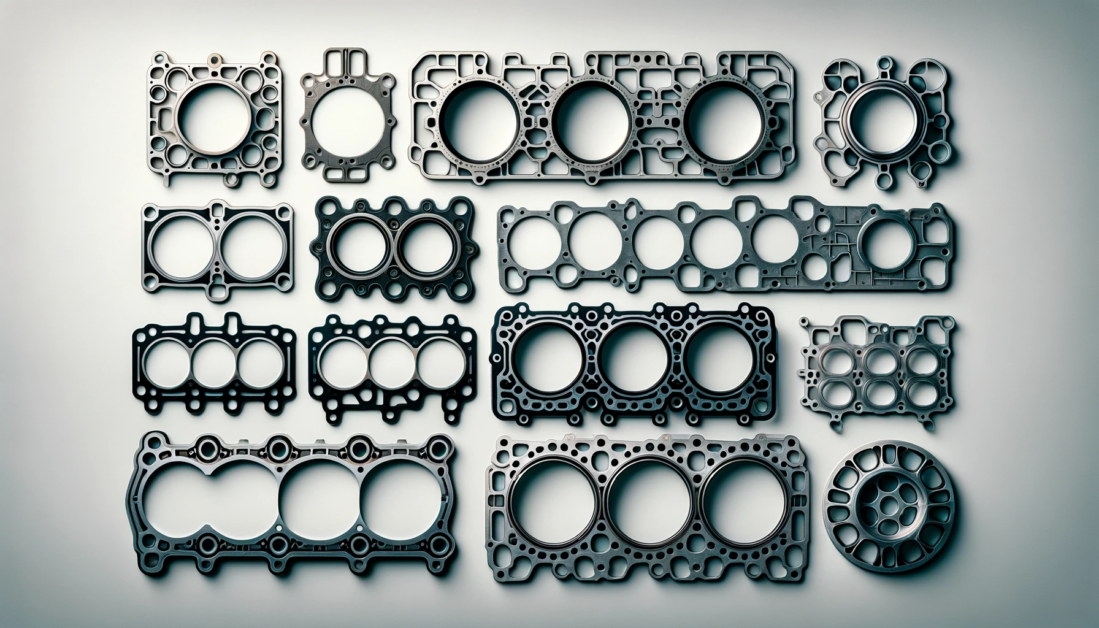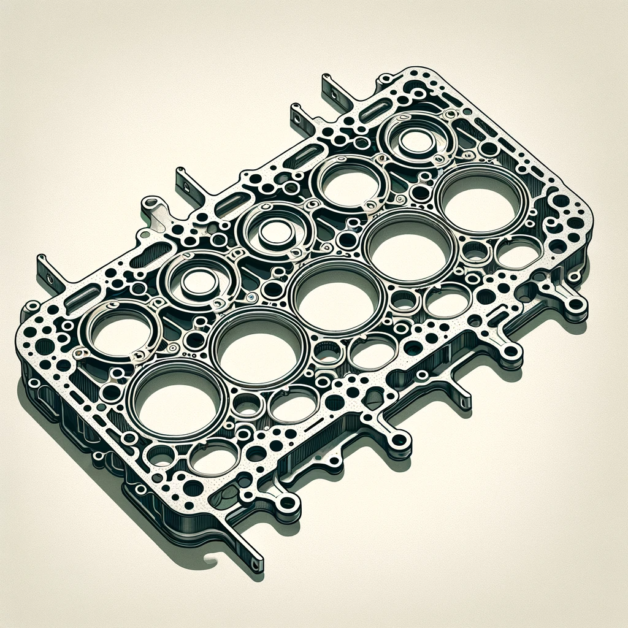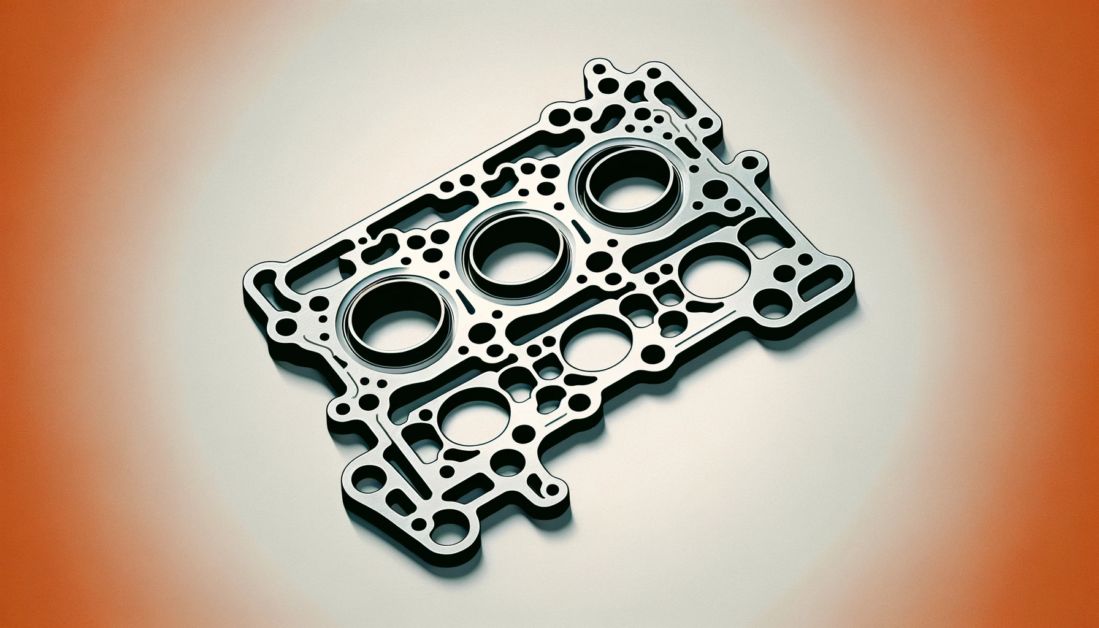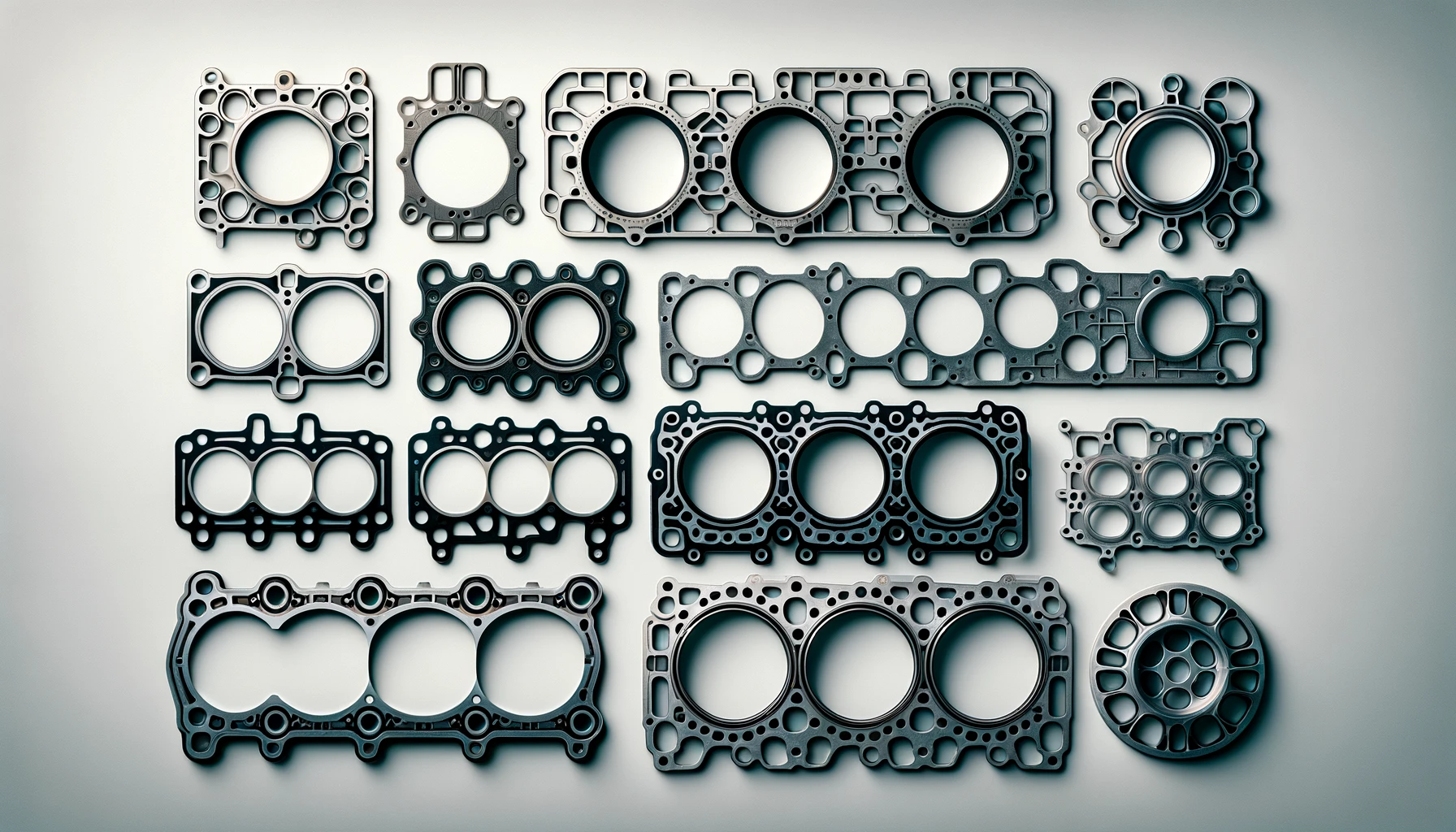
The head gasket is a small but crucial component that plays a vital role in your vehicle’s engine. Located between the cylinder head and the engine block, its primary function is to seal the combustion process and allow coolant and oil to circulate for cooling and lubrication. However, a blown head gasket can cause significant damage, making it essential for vehicle owners to understand its purpose and how to recognize signs of failure.
Key Takeaways
- A head gasket seals the combustion process and enables coolant and oil circulation in the engine.
- A blown head gasket can lead to severe engine damage if left unaddressed.
- Symptoms of a blown head gasket include engine overheating, white smoke from the exhaust, loss of power, and discolored oil.
- Repairing a blown head gasket can be complex and expensive, and it’s important to address the issue promptly.
- Regular maintenance and professional assistance are crucial for maintaining the longevity and performance of the head gasket.
What is a Head Gasket?

The head gasket is a critical component of a vehicle’s engine, located between the cylinder head and the engine block. Its primary function is to seal the combustion chamber and allow the circulation of coolant and oil within the engine for cooling and lubrication purposes. This small but crucial part plays a vital role in maintaining the overall health and performance of the engine.
The head gasket acts as a barrier between the combustion chamber and the engine coolant and oil passages. It ensures that these fluids do not mix and maintains the correct pressure in the combustion chamber. In modern vehicles, head gaskets are typically made of durable steel material combined with elastomer, which enhances their durability and resistance to leakage compared to older gasket materials such as graphite or asbestos.
The combustion process in the engine generates high temperatures and pressures, and the head gasket is designed to withstand these extreme conditions. It forms a tight seal between the cylinder head and engine block, preventing the escape of combustion gases and the leakage of coolant or oil. This seal is crucial for the engine’s efficient operation and preventing damage to other engine components.
Table: Head Gasket Components
| Component | Description |
|---|---|
| Steel Layers | Durable steel layers provide strength and resistance to combustion pressures. |
| Elastomer | Elastomer material ensures flexibility and tight sealing properties. |
| Combustion Sealing Rings | Sealing rings provide additional sealing around the combustion chambers. |
| Coolant Passages | Channels within the head gasket allow the circulation of coolant for engine cooling. |
| Oil Passages | Passages within the head gasket allow the circulation of oil for engine lubrication. |
What Causes a Head Gasket to Blow?
A blown head gasket is a common issue that can cause significant damage to the engine, so understanding what causes it is essential for vehicle owners. The primary cause of a blown head gasket is engine overheating, which is often the result of a coolant leak. When the engine overheats, the cylinder head expands and weakens, compromising the seal of the head gasket and leading to a blowout. If left untreated, a blown head gasket can cause irreversible damage to the engine.
Engine overheating can be caused by various factors, such as a faulty thermostat, a malfunctioning cooling fan, or a damaged radiator. These issues can lead to coolant leaks, reducing the coolant level and resulting in overheating. It’s important to address coolant leaks promptly to prevent damage to the head gasket and other engine components.
In some cases, a blown head gasket may also be caused by other factors, such as excessive pressure in the combustion chamber or poor installation of the gasket itself. However, these instances are relatively rare compared to engine overheating and coolant leaks.
Common Causes of a Blown Head Gasket:
- Engine overheating due to coolant leaks
- Faulty thermostat
- Malfunctioning cooling fan
- Defective radiator
- Excessive pressure in the combustion chamber
- Poor installation of the head gasket
| Causes | Effects |
|---|---|
| Engine overheating due to coolant leaks | Blown head gasket, potential engine damage |
| Faulty thermostat | Engine overheating, blown head gasket |
| Malfunctioning cooling fan | Engine overheating, blown head gasket |
| Defective radiator | Coolant leaks, engine overheating, blown head gasket |
| Excessive pressure in the combustion chamber | Blown head gasket |
| Poor installation of the head gasket | Blown head gasket |
Recognizing the signs of a blown head gasket and addressing the underlying causes promptly can help prevent engine damage and costly repairs. Regular maintenance, including checking for coolant leaks and ensuring the cooling system is functioning properly, is crucial for preventing head gasket failures.
Blown Head Gasket Symptoms

A blown head gasket can manifest in several symptoms that vehicle owners should be aware of. Recognizing these signs is crucial for identifying potential head gasket issues and taking prompt action to prevent further damage to the engine.
Overheating
One of the common symptoms of a blown head gasket is engine overheating. When the head gasket fails, it can cause a coolant leak, leading to a decrease in coolant levels. Insufficient coolant can result in the engine running at higher temperatures, which may trigger the overheating warning on the dashboard. If you notice your engine temperature rising rapidly or the warning light illuminating, it could indicate a blown head gasket.
White Smoke
Another telltale sign of a blown head gasket is the presence of white smoke coming from the vehicle’s exhaust. This white smoke is usually caused by coolant entering the combustion chamber and being burned along with the fuel. The coolant reacts with the heat, resulting in the emission of white or light-colored smoke. If you see white smoke billowing from your exhaust, it’s a strong indication of a blown head gasket.
Loss of Power
A loss of power while driving can also be attributed to a blown head gasket. The failure of the head gasket can disrupt the combustion process, leading to reduced engine performance and power output. If you experience a sudden loss of power or notice a significant decrease in acceleration, it may be due to a blown head gasket.
It is essential to address these symptoms promptly to prevent further damage to the engine. If you observe any of these signs, it is recommended to consult a professional mechanic for a thorough diagnosis and necessary repairs.
Head Gasket Repair Options
When faced with a blown head gasket, it’s important to consider the available repair options. Repairing a blown head gasket can be a complex process that often involves disassembling the engine to access the gasket. The cost of head gasket repair can vary depending on the extent of the damage and the specific vehicle.
Head Gasket Repair
Head gasket repair involves removing the cylinder head, replacing the gasket, and reassembling the engine. This repair option is best suited for cases where the damage is localized to the head gasket and the rest of the engine is in good condition. However, it’s important to note that the repair costs can be significant, often exceeding $1,000 due to the labor-intensive nature of the process.
Head Gasket Replacement
In some cases, it may be more cost-effective to replace the entire engine instead of just the head gasket. This is especially true if there is extensive damage to the engine or if the vehicle is older and has high mileage. While engine replacement can be a more expensive option upfront, it can provide a longer-term solution and may be more cost-effective in the long run.
Repair Costs
The cost of head gasket repair can vary depending on various factors, including the make and model of the vehicle, the severity of the damage, and the labor rates in your area. It’s recommended to obtain a cost estimation from a trusted mechanic to get a more accurate idea of the repair costs for your specific situation.
| Repair Option | Pros | Cons |
|---|---|---|
| Head Gasket Repair | – Less expensive than engine replacement | – Labor-intensive process |
| Head Gasket Replacement | – Can provide a longer-term solution | – More expensive upfront |
Importance of Timely Repair
Addressing a blown head gasket promptly is crucial to prevent further engine damage and potential engine replacement. Ignoring the issue can lead to severe consequences, including decreased engine performance and even complete engine failure. Coolant and oil leaks caused by a blown head gasket can contaminate crucial engine components, resulting in irreversible damage. It is essential to recognize the symptoms of a blown head gasket and take immediate action to avoid costly repairs and extensive engine damage.
By addressing a blown head gasket in a timely manner, vehicle owners can avoid the need for expensive engine replacements. Repairing the head gasket before it causes further damage can save both time and money. A professional assessment of the extent of the damage is recommended to determine the most suitable repair option. Professional assistance ensures that the repair process is carried out correctly, minimizing the risk of additional complications and ensuring the longevity and performance of the repaired head gasket.
Effects of Engine Damage
Engine damage caused by a blown head gasket can have a significant impact on the overall performance and reliability of the vehicle. The compromised seal between the cylinder head and the engine block can result in decreased compression, leading to a loss of engine power. Additionally, coolant and oil leaks can cause overheating, which further exacerbates engine damage and reduces overall efficiency. Taking the necessary steps to repair a blown head gasket in a timely manner helps maintain optimal engine performance and prevents further complications.
| Engine Damage | Engine Replacement |
|---|---|
| Decreased engine power | Costly and time-consuming |
| Reduced fuel efficiency | Requires complete engine overhaul |
| Increased risk of engine failure | Disruption to regular vehicle use |
Head Gasket Maintenance Tips
Proper maintenance of the coolant system is crucial for ensuring the longevity and performance of your vehicle’s head gasket. Regular inspections and proactive measures can help identify potential issues before they escalate into costly repairs. Here are some head gasket maintenance tips to keep in mind:
1. Check for Coolant Leaks
Regularly inspect your vehicle for any signs of coolant leaks. Look for puddles of coolant under the car or on the ground, as well as any noticeable decrease in coolant levels. Coolant leaks can lead to overheating and put unnecessary strain on the head gasket, so addressing them promptly is essential.
2. Maintain Proper Coolant Levels
Ensure that your vehicle always has the correct coolant levels. Low coolant levels can cause the engine to overheat, potentially leading to head gasket failure. Refer to your owner’s manual for specific instructions on checking and topping up the coolant.
3. Perform Regular Inspections
Regularly inspect the engine bay for any signs of oil or coolant leaks. Pay attention to any unusual smells, such as a sweet or burnt odor, as they may indicate a head gasket issue. Additionally, monitor your vehicle’s temperature gauge closely to detect any abnormal temperature fluctuations.
| Head Gasket Maintenance Tips |
|---|
| Check for Coolant Leaks |
| Maintain Proper Coolant Levels |
| Perform Regular Inspections |
By following these head gasket maintenance tips, you can help prevent potential problems and prolong the life of your head gasket. Remember to consult your vehicle’s owner’s manual for specific maintenance guidelines and always seek professional assistance if you suspect any head gasket issues.
Head Gasket Replacement Process
Replacing a head gasket is a complex task that involves engine disassembly and should typically be performed by a professional. The process includes several steps to ensure the proper removal and installation of the gasket.
First, the technician will drain the engine coolant and disconnect various components, such as the intake and exhaust manifolds, to gain access to the cylinder head. Then, they will remove the cylinder head bolts and carefully lift off the cylinder head to expose the old gasket.
Next, both the cylinder head and engine block surfaces must be thoroughly cleaned and inspected for any damage or warping. If necessary, the surfaces may need to be machined to ensure a proper seal. Once the surfaces are clean and smooth, the new head gasket can be positioned and the cylinder head reinstalled, followed by the reassembly of all the components that were removed.
Head Gasket Replacement Process:
| Step | Description |
|---|---|
| 1 | Drain engine coolant and disconnect necessary components |
| 2 | Remove cylinder head bolts and lift off the cylinder head |
| 3 | Clean and inspect cylinder head and engine block surfaces |
| 4 | Machine surfaces if necessary |
| 5 | Position and install new head gasket |
| 6 | Reinstall cylinder head and all other components |
It is important to note that the head gasket replacement process can vary depending on the specific vehicle make and model. Additionally, specialized tools may be required for certain steps, making professional assistance essential to ensure the job is done correctly and efficiently.
Quality Head Gasket Brands
When it comes to head gasket replacement, choosing a reputable brand is crucial for ensuring durability and performance. Several trusted brands specialize in automotive sealing solutions, offering high-quality head gaskets that meet industry standards. Let’s take a look at some of the top brands in the market:
Fel-Pro
Fel-Pro is a well-known name in the automotive industry, renowned for its reliable gaskets. They use advanced technologies and high-quality materials to manufacture head gaskets that provide excellent sealing and longevity. Fel-Pro gaskets are designed to withstand high temperatures, pressure, and various engine conditions, making them a popular choice among car enthusiasts and professionals alike.
Victor Reinz
Victor Reinz is another reputable brand that specializes in sealing solutions. With a focus on innovation and quality, they offer head gaskets that provide superior performance and durability. Victor Reinz gaskets are designed to meet or exceed OEM specifications, ensuring a precise fit and reliable sealing for your engine.
MAHLE
MAHLE is a global leader in engine components, including head gaskets. Their gaskets are engineered using advanced technologies and high-quality materials to deliver exceptional performance and reliability. MAHLE head gaskets are known for their excellent heat resistance, superior sealing properties, and long lifespan, making them a top choice for professional engine builders and mechanics.
Cometic Gasket
Cometic Gasket is a renowned brand in the world of high-performance engines. They specialize in manufacturing custom head gaskets for various applications, including racing and modified engines. Cometic gaskets are made from multi-layer steel or elastomer materials, offering superior sealing capabilities, resistance to high temperatures, and excellent durability.
Elring
Elring is a trusted supplier of original equipment (OE) gaskets for many automotive manufacturers. Their head gaskets are known for their precision fit, high-quality construction, and reliable sealing performance. Elring gaskets meet stringent OE specifications, ensuring compatibility and optimal engine performance.
| Brand | Features |
|---|---|
| Fel-Pro | Advanced technologies, high-quality materials, excellent sealing |
| Victor Reinz | Precision fit, reliable sealing, OEM specifications |
| MAHLE | Exceptional heat resistance, superior sealing, long lifespan |
| Cometic Gasket | Custom options, multi-layer steel or elastomer materials, high durability |
| Elring | Precision fit, OE supplier, reliable sealing performance |
Head Gasket Manufacturing Process
The manufacturing process of a head gasket involves the careful combination of multiple layers of steel with elastomer. This combination creates a gasket that is durable, reliable, and able to withstand the high pressures and temperatures within the engine.
Specialized manufacturing equipment is used to create head gaskets with precise dimensions and sealing properties. This equipment ensures that each gasket is made to the exact specifications required for optimal performance. The multi-layer steel construction of the gasket provides strength and resilience, while the elastomer adds flexibility and sealing capabilities.
During the manufacturing process, each layer of steel and elastomer is carefully bonded together to create a strong and leak-proof seal. This ensures that the head gasket can effectively withstand the pressures and temperatures generated by the engine’s combustion process. Quality control measures are also implemented to ensure that each gasket meets stringent industry standards for durability and performance.
| Materials | Manufacturing Process |
|---|---|
| Multiple layers of steel | Each layer is bonded with elastomer to create a strong seal |
| Elastomer | Provides flexibility and sealing capabilities |
| Specialized manufacturing equipment | Ensures precise dimensions and sealing properties |
The head gasket manufacturing process is essential for producing gaskets that are capable of withstanding the harsh conditions of the engine. The combination of multi-layer steel and elastomer provides the necessary strength, flexibility, and sealing capabilities required for optimal performance. By utilizing specialized equipment and adhering to strict quality control measures, manufacturers can ensure that each head gasket meets the highest standards of durability and reliability.
Factors Affecting Head Gasket Lifespan
The lifespan of a head gasket can be influenced by various factors, including driving style, maintenance practices, and the design of the gasket itself. Understanding these factors can help vehicle owners optimize the durability and longevity of their head gaskets.
Driving Style
The way a vehicle is driven can have a significant impact on the lifespan of the head gasket. Aggressive driving habits, such as excessive accelerating, hard braking, and rapid changes in speed, can put additional strain on the engine and increase the risk of overheating. This can lead to premature wear and tear on the head gasket, reducing its effectiveness and lifespan. On the other hand, adopting a smoother, more moderate driving style can help minimize stress on the gasket and promote its longevity.
Maintenance
Regular maintenance is crucial for preserving the health of the head gasket. Proper coolant and oil levels should be maintained to ensure optimal engine temperature and lubrication. Regularly scheduled inspections can help identify and address potential issues before they escalate. Additionally, promptly addressing any symptoms of a failing head gasket, such as overheating or loss of power, can help prevent further damage and extend the gasket’s lifespan.
Design
The design and quality of the head gasket can also play a role in its lifespan. Gaskets made from high-quality materials, such as multi-layer steel and elastomer, tend to offer better durability and resistance to leakage compared to older gasket designs. It is important to choose gaskets from reputable brands that specialize in automotive sealing solutions to ensure optimal performance and longevity.
| Factors Affecting Head Gasket Lifespan | Description |
|---|---|
| Driving Style | The way a vehicle is driven, with aggressive driving habits putting additional strain on the gasket. |
| Maintenance | Regular maintenance, including maintaining proper coolant and oil levels, can help preserve the gasket’s lifespan. |
| Design | Gaskets made from high-quality materials with modern designs tend to offer better durability and resistance to leakage. |
Head Gasket Repair Cost
When it comes to repairing a head gasket, the cost can vary depending on the extent of the damage and the type of vehicle. In most cases, head gasket repair costs can exceed $1,000, reaching up to $3,000 or more, primarily due to the extensive labor involved in the repair process. It’s important to note that this cost estimation is for the repair alone and does not include any additional repairs or parts that may be needed.
It is recommended to obtain a cost estimation from a trusted mechanic before proceeding with the repair. They will be able to assess the extent of the damage and provide an accurate estimate based on their expertise and knowledge. Keep in mind that the cost of the repair can also be influenced by factors such as the location of the repair facility and the specific model of the vehicle.
Considering the potential expenses involved in head gasket repair, it’s essential to weigh the cost against the overall condition of the vehicle. In some cases, the cost of repairing a blown head gasket may be comparable to or even exceed the cost of replacing the entire engine. This is especially true if the engine has suffered significant damage as a result of the blown head gasket. It is important to consider the long-term cost-effectiveness of each option and consult with a trusted professional for their expert advice.
Head Gasket Repair vs. Engine Replacement
When faced with a blown head gasket, vehicle owners are often confronted with the decision of whether to opt for head gasket repair or engine replacement. This choice can be influenced by factors such as cost, extent of engine damage, and overall condition of the vehicle. To make an informed decision, it’s important to consider the advantages and limitations of each option.
Head Gasket Repair
Repairing the head gasket involves disassembling the engine and replacing the faulty gasket. This process requires technical expertise and specialized tools, making professional assistance highly recommended. The cost of head gasket repair can vary depending on the extent of the damage and the make and model of the vehicle. In most cases, head gasket repair can range from a few hundred dollars to over a thousand dollars.
Engine Replacement
On the other hand, engine replacement involves swapping the entire engine unit with a new or rebuilt one. This option can be more expensive than head gasket repair, as it includes the cost of the engine itself and the labor involved in the replacement process. Engine replacement costs can vary significantly depending on the vehicle’s make and model, ranging from several thousand dollars to tens of thousands of dollars.
When deciding between head gasket repair and engine replacement, it’s crucial to consider the extent of the engine damage. If the damage is limited to the head gasket and other components are in good condition, head gasket repair may be a viable and cost-effective solution. However, if the engine has suffered extensive damage or is nearing the end of its lifespan, engine replacement may be the more practical option to ensure long-term reliability.
| Factors | Head Gasket Repair | Engine Replacement |
|---|---|---|
| Cost | Varies depending on the extent of damage and vehicle | Higher cost due to engine replacement |
| Extent of Engine Damage | Limited to head gasket | Extensive damage beyond head gasket |
| Vehicle Condition | Other components in good condition | High mileage or other significant issues |
Conclusion and Expert Assistance
Understanding the function of a head gasket and recognizing the signs of potential failure are crucial for vehicle owners. Timely action is essential to prevent severe engine damage and costly repairs. If you suspect a blown head gasket, it is recommended to seek expert head gasket repair from professional assistance.
Experienced mechanics and technicians have the knowledge, skills, and specialized tools to accurately diagnose and repair head gasket issues. They can thoroughly assess the extent of the damage and provide a reliable solution to restore your engine’s performance. Trusting professionals for head gasket repair ensures that the job is done correctly and efficiently.
In addition to seeking expert assistance, engine maintenance plays a vital role in prolonging the lifespan of your head gasket. Regular inspections, proper coolant system maintenance, and addressing any issues promptly can help prevent future head gasket failures. Remember, proactive maintenance is key to keeping your engine running smoothly.
By understanding the importance of expert assistance and engine maintenance, you can take the necessary steps to protect your vehicle’s head gasket and overall engine health. Don’t hesitate to consult a reliable mechanic to address any head gasket concerns and ensure your vehicle’s optimal performance and longevity.
FAQ
What is a head gasket?
The head gasket is a small but essential component located between the cylinder head and the engine block. Its primary function is to seal the combustion process and allow coolant and oil to circulate throughout the engine for cooling and lubrication.
What causes a head gasket to blow?
The most common cause of a blown head gasket is engine overheating, usually due to a lack of coolant caused by a leak. High engine temperatures can cause the cylinder head to expand and weaken, compromising the seal of the head gasket.
What are the symptoms of a blown head gasket?
Symptoms of a blown head gasket include engine overheating, white or blue smoke coming from the exhaust, loss of power, and the presence of discolored oil.
How can a blown head gasket be repaired?
Repairing a blown head gasket often involves disassembling the engine to access the gasket and replacing it. The cost of head gasket repair can vary depending on the vehicle and the extent of the damage.
Why is it important to address a blown head gasket promptly?
Ignoring a blown head gasket can lead to severe engine damage. Coolant and oil leaks can contaminate critical engine components, leading to decreased engine performance and potential failure. Addressing the issue promptly can prevent further damage and the need for expensive engine replacements.
How can I extend the lifespan of a head gasket?
Proper maintenance of the coolant system is essential for preventing head gasket failures. Regularly checking for leaks, ensuring proper coolant levels, and performing routine inspections can help identify and address potential issues before they escalate.
Should I seek professional assistance for head gasket replacement?
Yes, replacing a head gasket involves a complex process that requires engine disassembly. It is recommended to seek professional assistance for this repair, as it requires technical knowledge and expertise.
Which brands offer high-quality head gaskets?
Reputable brands that offer high-quality head gaskets include Fel-Pro, Victor Reinz, MAHLE, Cometic Gasket, and Elring. These brands specialize in automotive sealing solutions and provide gaskets that meet industry standards for durability and performance.
What is the manufacturing process of a head gasket?
The head gasket manufacturing process involves combining multiple layers of steel with elastomer to create a durable and reliable gasket. Specialized manufacturing equipment is used to produce head gaskets with precise dimensions and sealing properties.
What factors can affect the lifespan of a head gasket?
Factors such as driving style, proper maintenance, and the design of the gasket can affect its longevity. Regular maintenance and addressing issues promptly can help extend the lifespan of the head gasket.
How much does head gasket repair cost?
The cost of repairing a head gasket can vary depending on the extent of the damage and the vehicle. In most cases, head gasket repair costs can exceed $1,000 due to the extensive labor involved in the repair process. Obtaining a cost estimation from a trusted mechanic is recommended.
Should I repair the head gasket or replace the entire engine?
In some cases, the cost of head gasket repair may be comparable to or even exceed the cost of replacing the entire engine. It is essential to consider the extent of engine damage, the overall condition of the vehicle, and the cost-effectiveness of each option when deciding between repair and replacement.
Why is expert assistance important for head gasket repair?
Understanding the function of a head gasket, recognizing its potential failure signs, and addressing issues promptly can help prevent severe engine damage. Seeking expert assistance and regular engine maintenance are crucial for ensuring the longevity and performance of the head gasket and the overall engine.


